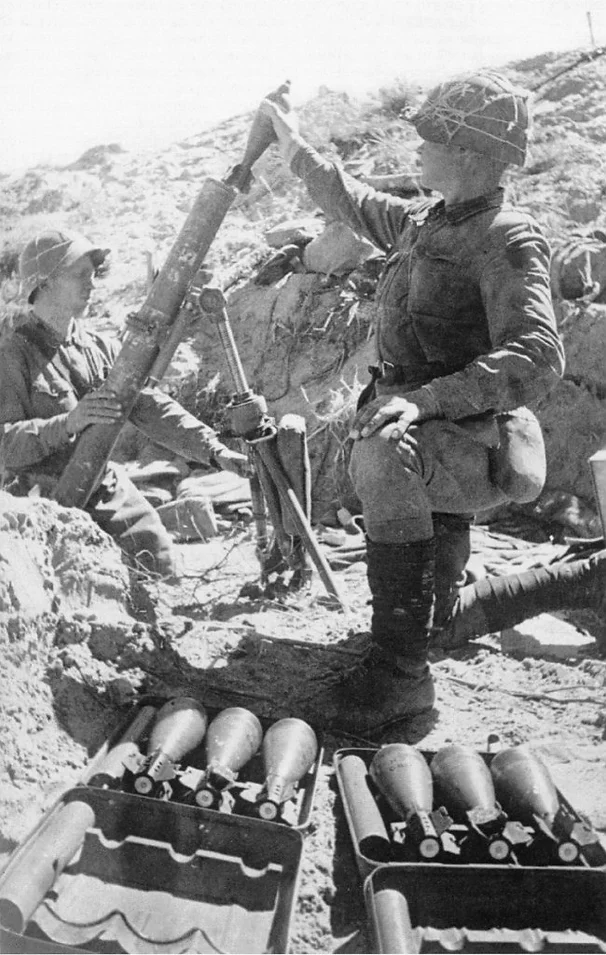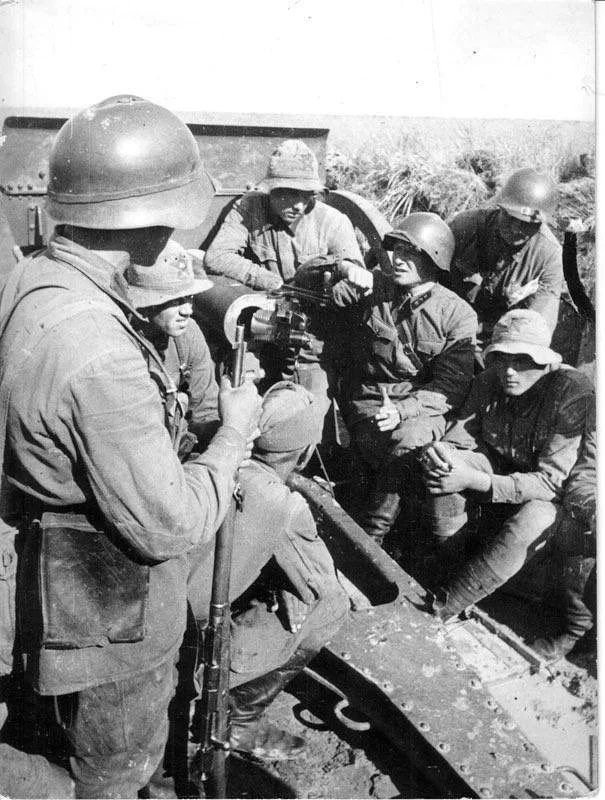1939 Khalkhin Gol
By Military History Research Club "Red Samurai"
This guide was made and is under the control of the Red Samurai Group, and is the regulation for their events. There are photos that support prohibited equipment inline with their regulations. For the events hosted by Red Samurai, per their regulation some of the equipment used at the time is prohibited, such as canvas shovel carriers and canvas bayonet scabbards. All credit for this guide and the information gathered goes to Military History Research Club “Red Samurai”. They are an excellent group of Soviet reenactors based out of Japan. Istochnik would like to give a massive thanks to them for allowing us to feature their guide on our site. Click below for more information about them!

Regulation Overview
Clothing
Cotton non-commissioned officer’s pilotka
1935 type rank insignia
Tunic for non-commissioned officers made of cotton
Trousers for non-commissioned officers made of cotton
Non-commissioned officer’s shinel *Please check the details
Undergarments for Soldier
Trouser belt
Leather belt
Collar liner
Footwraps
Leather boots or low-boots and black puttees
Equipment
SSH-36 helmet
Assault suspenders “Y straps”
Two-chamber type with ring or box-type ammunition pouch with ring
Leather bayonet scabbard *optional
РГД-33 grenade bag or shoulder grenade bag
Old-style shovel and leather shovel bag
Canteen and shoulder bag *Please check details
Old or new gas mask
Unpainted or painted kidney-shaped messkit
1936 model backpack
1891/30 Rifles and bayonets, leather slings
Regulation Details
About the cap for non-commissioned officers
“Cotton non-commissioned officer cap (Pilotka)”
Sand/khaki color is recommended for the cotton non-commissioned officer cap.
Please attach the 1936, 1939, and 1947 small cap stars.
Painted cap stars cannot be used.
Do not use plastic cap stars.
~ About the cap star ~
Please refer to the 1936 type cap badge (small cap star, medium cap star), 1939 type cap badge (medium cap star), 1947 type cap star (small cap star, medium cap star)
About Field Uniform for Soldiers
“Cotton field uniform for non-commissioned officers (Gymnastyorka)”
Please use Gymnastyorka (Obr. 35) other than the 42 model as quality control.
Trousers for non-commissioned officers
“Cotton trousers for non-commissioned officers “
As long as the fabric is made of cotton, you can use any of the replicas that are currently on sale, but you cannot use those that do not have knee pads.
You can substitute cotton pants with knee pads if they are made of trouser fabric used by the Soviet Army after the war.
Both 1935 and 1944 models can be used, but please prepare the 1935 model if possible.
Be sure to check for seams in the calf area when using surrogate Soviet military or other organizations after the war. Pants with seams at the calves are not allowed.
Old Japanese army trousers cannot be used as a substitute.
- You can get these trousers from Voin, Schuster, and Voenspec
Undergarments for non-commissioned officers
“Soldier’s underwear” – A shirt worn under the field uniform. Both reproduction and post-war products can be used, summer is preferred but winter is also acceptable.
Shinel for non-commissioned officers
“Soldier’s Overcoat”
Please prepare the overcoat as it is necessary to tie it to the backpack.
You can wear a 1938 type cloak for a non-commissioned overcoat.
Post-war Soviet military non-commissioned officer cloaks and 1941 model cloaks can be tied to the backpack.
If you wear it, please attach the 1935 infantry “raspberry” insignia.
If you wear it, please use black buttons on the back.
Equipment Belt
Jackboots and Lowboots
Wear jackboots or a combination of lowboots and puttees and wear them well to prevent blisters. In addition, the presence or absence of shoe sole protectors and tacks does not matter.
” leather boots “
Avoid leather postwar products, please use quality reproductions
Please be sure to wear porchanki (foot cloth) or socks
Kirza boots are NOT allowed, leather soles are needed.
“Lowboots and puttees”
The color of the puttees is limited to black only.
Substitute boots made of leather (including synthetic leather) can be used, but please avoid items that are significantly different.
Please be sure to wear portyanki (foot cloth) or socks.
Helmet
Please use a SSH-36 helmet
It is acceptable to have both the star painted on the front or no star.
The material of the chin strap, such as leather or canvas, does not matter.
Avoid camouflage paint and covers as this was not the standard for Khalkhin Gol.

Ammunition Pouches
Both box type and two-chamber type can be used.
The post-war Kirza cloth ammunition box shown cannot be used.
Use two ammo pouches instead of one, one one either side of the belt buckle.
Fill the pouch and adjust the shape to get the correct form/look.


Shovel/E-tool
Although a canvas portable shovel carrier is also used, this time we will use a leather portable shovel carrier, which is often used, as a control equipment.
You can use either pointed or flat.
Please use older tsarist model shovels if possible.
Please use a leather shovel carrier.
The shovel carrier can be a leather replica for imperial Russia.
Gas Mask and Bag
You can use duplicates of both the old and new gas mask (referred to as old and new for convenience).
Please pack a gas mask (regardless of age type) and a towel etc. in the gas mask bag.
People who have an old-style gas mask with a snap button to fix the lid (lower left figure) should definitely use it.


Grenade Pouch
Among the examples of grenade bag usage, there are photographs of the grenade hanging from the equipment belt with a wire, etc., but if you hang a grenade imitation directly from the equipment belt in outdoor activities, there is a risk of damage or injury. Because of that, you’ll need to use some kind of grenade pouch. There are РГ-14/30 grenades, РГД-33 and Ф-1 grenades as examples of grenade use and excavated items.
Since the replica 1915 model grenade bag (right shoulder) and the same type of grenade bag are also used here and there, you may use the replica model 1915 model grenade bag (right shoulder) as a substitute. Please note that the replica 1915 model grenade bag has a right shoulder strap and a left shoulder strap, so please be careful when purchasing.
Use the РГД-33 grenade bag (for the equipment belt, bottom right) or the replica 1915 model grenade bag (right shoulder) as a substitute.
Pack duplicate grenades and towels.




Canteen
Most of the examples of the use of canteens in the battlefield photos of the Battle of Khalkin Gol (Nomonhan Incident) are shoulder canteens and canteens. I presume that a 1L canteen and a 1L water canteen carrier on the shoulder were mainly used. However, although the date of abandonment is unknown, 0.7L canteens (unpainted) of the same type as those shown in 1 and 2 below have also been excavated as excavated items from the battlefield. You may use a suitable water bottle. If you have a 1 liter canteen and a 1 liter canteen carrier on your shoulder, please bring it with you to see how it looks in the photos.
1: 1940’s Canteen, 2: East German reparation canteen, 3: 1950’s Canteen, 4: 1980’s Canteen
Canteens can be used regardless of whether they are painted or not.
The shape of the canteen lid, such as a screw or a stopper, does not matter.
Use a shoulder carrier and a matching canteen.




Mess Kit
Required for binding to the Obr. 36 ranets.
Since the khaki-painted one has been used since the Battle of Khalkhin Gol, the recommendation for this event is the unpainted kidney-shaped cooker.
The unpainted one can be tied to the backpack as it is.
When eating, you can use unpainted pot, mess kit, enamel plates, etc.
Be sure to put the painted items in the mess kit cover and tie them down.
Post-war Soviet military ones can also be substituted if no other option is available.


Backpack
I can’t find a clear usage example photo, but as a guess, I think it’s safe to use meshok or 1936 model backpack. A this time, we will keep the standard with the 36 model backpack.
- Please use the model 36 backpack.
With or without a belt on the dorsal lid is fine.
Early/middle/late model and 36 model for post-war parades.
Bayonet Scabbard
In some cases the scabbard is equipped, and some are not. In this event, we will consider it as optional equipment. Cloth ones are also seen here and there, but please use only leather bayonet scabbards. On the right, an example of using a leather bayonet scabbard, a non-commissioned officer in a military cap? 1915 model grenade bag (right shoulder)? A bayonet inserted into a leather bayonet scabbard can be seen below.


























